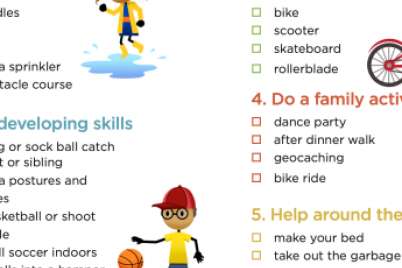
Could 2020 be the year of outdoor learning?
2020’s back-to-school season is unlike any we’ve experienced before. If there’s one silver lining to months of Zoom lessons and uncertainty, it’s the renewed (or continued) use and appreciation of our natural spaces and the outdoors.
Adapting lessons to outdoor settings
As our kids’ schools press the reset button, it’s a unique opportunity for school districts to reimagine the school day, and explore and integrate outdoor recreational spaces and fresh-air classrooms.
Outdoor classrooms encourage healthy heart-pumping play and sensory stimulation, and offer a solution to overcrowded and poorly-ventilated classrooms.
It may not be a one-size-fits-all solution—because of differences in available space and diverse climates—but it makes sense to incorporate outdoor learning as a greater portion of the school day, rather than a rare occurrence.
Related read: Teachers, take your kids outside (yes, during class time)
Toronto’s Hospital for Sick Children [PDF], educators, and even politicians are recommending more time outdoors as a beneficial—and safer—alternative to traditional four-walled classrooms.
To mitigate the risk of COVID-19 in schools and support kids’ learning and healthy development, the Canadian government’s COVID-19 guidance for schools resource emphasizes personal preventive practices, including respiratory etiquette, hand hygiene, and wearing non-medical masks. It also encourages moving classrooms outside when space and weather permit.
Many benefits to learning outside
While countries around the globe grapple with the effects of COVID-19 and its disruption of children’s schooling, some places are looking to forest schools and land-based learning for inspiration.
Forest, or open-air, schools were launched over a century ago and have been familiar to early childcare educators in Europe for decades. Their popularity has spread across Canada, where math, science, and physical literacy are all explored in an outdoor setting.
Today, outdoor learning can offset some of the stresses of our kids’ prolonged confinement and much-missed social interaction. It can counter physical inactivity due to COVID-19 restrictions, and even help them better enjoy school! And by simply being outdoors children are getting sun exposure (Vitamin D) and exercise. Both are crucial to a strong immune system.
Outdoor environments can even improve children’s interest and attention, and have even been shown to decrease the symptoms of ADHD.
Related read: How integrating outdoor play into the school day benefits children
Schools in Canada and worldwide are trying out new learning environments
“Classrooms” can range from low- to no-cost options, like a patch of grass under a tree to temporary structures like the tents installed at Pierre Elliott Trudeau Elementary School in Gatineau, Que., and professionally built outdoor classroom systems that will last after the pandemic.

To integrate outdoor learning this fall, Shatford Memorial Elementary in Hubbards, N.S., built simple outdoor classrooms with large stones, wood benches, and stools for seating.
The principal at l’école St-Joseph in Val-d’Or, Que., changed this fall’s schedule to introduce two 50-minute periods per day outdoors.
And Eramosa Public School in Rockwood, Ont., has a brand new outdoor classroom where students and teachers can enjoy the double-sided white board, rock seating, picnic tables, and all-weather instruments:
In New York City, Mayor Bill de Blasio is encouraging schools to hold classes outdoors and make use of closed streets and nearby parks.
“Not only do we know that the virus spreads less easily outdoors, but we know our students need time to run, play, explore and create, and that happens outdoors,” New York City Schools Chancellor Richard Carranza told NBC New York.
Scotland’s first minister Nicola Sturgeon told The Guardian: “This might be the way that outdoor learning gets pushed forward, but it’s about so much more than infection control. Teachers do need support to do this: there are not many things you can’t teach outdoors; you just have to think creatively.”
But what about winter?
Outdoor learning can happen in all types of climates. Students participating in a pilot project at Nanook School in Iqaluit took their lessons outside to a tupik tent. There, traditional math and science classes mixed with lessons from community elders. And at Equinox, the Toronto District School Board’s alternative elementary school, outdoor learning is embraced year-round. Students go indoors only in extreme weather.
Related read: How to dress for the weather in every season
Supporting outdoor student learning
“Taking your class outdoors is not an act of rebellion, or even edgy pedagogy, it is simply good practice.”
– B.C. educator Megan Zeni in her 10 tips for teaching outside the classroom
Here are some quality resources from outdoor play advocates and educators to support teachers and schools interested in outdoor learning:
- The Child and Nature Alliance of Canada has launched Thrive Outside to help educators with nature-based learning and play.
- Outdoor Classroom Day shares ideas and inspiration on how to more time outdoors every day.
- Outdoor Council of Canada offers a wide range of how-to guides, tips, and a list of schools with established outdoor classrooms.
- Plant a Seed & See What Grows Foundation supports outdoor education in Canada and shares educational resources and ideas.
- The Outdoor PLAYbook team shares inspirational projects and planning and building advice for new outdoor play spaces or learning environments.
- Take Me Outside lists groups and organizations involved with outdoor classrooms.
- Ontario Society for Environmental Education has tips on taking learning outside using 100-metre field trips.
- Enseigner dehors is a project aimed at inspiring, training, and supporting workers in elementary and secondary schools in Quebec.






Love this! Thank you for sharing such an insightful article!
Excellent!